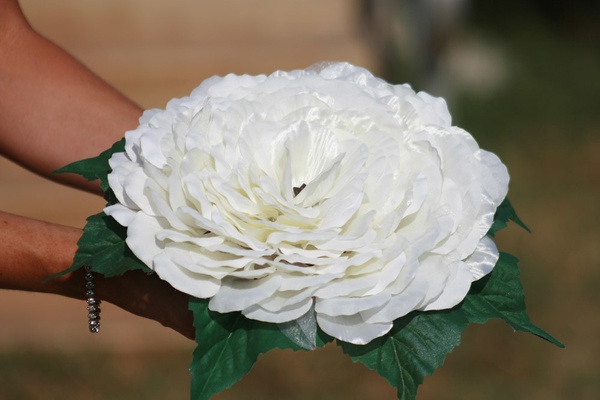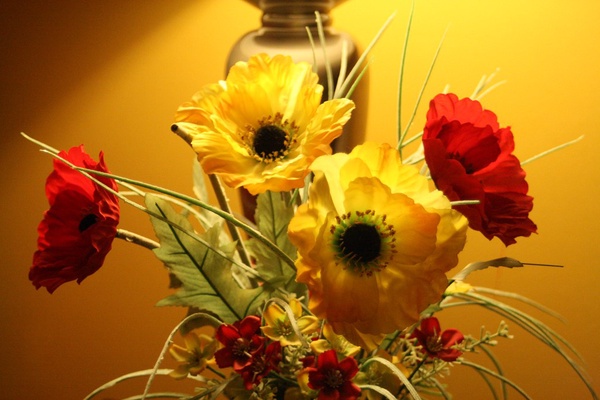
creativecommons.org
A silk flower is a unique decorative element used in completely different areas of design. It perfectly complements wedding compositions, giving the decorations incredible shine and grace. Soap and silk flowers are used to decorate festive tables in luxury restaurants. Red silk looks amazing in bouquets created by professionals. Another industry where you can find a lot of silk jewelry is accessories. The depth of color of silk products is complemented by a noble shine. That’s why it is used to decorate hairpins, hoops, and jewelry.
The fabric is unique due to its triangular cross-section. Rays of light are refracted in it, creating an optical effect that is striking in its beauty. Other advantages of the material:
- Working with silk is a pleasure. It is elastic, stretches well, but is not prone to deformation.
- The material is able to isolate the body from tissue pests, so it is considered hygienic.
- The unique properties of the fabric prevent it from overheating, it protects the skin from overheating. This is why silk items are so pleasant to wear in hot weather.
- Silk is hygroscopic. It can absorb moisture in a matter of seconds.
Silk flowers - kanzashi master class

creativecommons.org
Modern kanzashi technique came to us from Japan. Every year it is gaining popularity. Fine jewelry is in demand all over the world. This technique uses different materials to create floral arrangements - velvet, velor, satin, silk and others. To make silk flowers in kanzashi style you need to prepare:
- Glue gun.
- Wide silk stripes of different colors.
- Scissors, needle, thread.
- Cellophane bag.
- Cardboard paper.
- Decorative elements. Flowers can be decorated with rhinestones, stones, beads and other little things.
A wide silk strip is cut into several pieces. Each one is seven centimeters long. Afterwards, the tape is folded in half and cut using a soldering iron. The cut is made at an angle. The opposite side of the tape turns in the other direction. The ending is also scorched. This allows the ends of the silk to be connected. It turns out to be a petal. The process can be repeated an unlimited number of times, depending on the number of required elements.
Next you will need paper - durable cardboard. Draw a circle on it. It becomes the basis for silk petals. The size of the accessory directly depends on the diameter of the circle. Glue the petals onto the circle, following the shape. There should be no gaps left, then the accessory will look like a living flower.
How to make silk flowers - water lily
Making flowers from silk is a long but interesting process. For example, to make an elegant water lily, you need to prepare:
- Thread and needle.
- Silk flap.
- Scissors, a few tailor's pins.
- Two pieces of plain material. They should differ from each other in color by several shades.
We cut sixteen squares of fabric with sides of 7.5 centimeters, eight squares with edges of five centimeters each. Step-by-step instructions for making a silk water lily:
- Divide large squares into several petals. Take the silk and fold it in half three times.
- We make a fold in the middle, in the lower corner - into the inner part. We pierce all the folds together. We use a pin. We stitch the place of the chip with a needle. Tighten the thread as tightly as possible and tie it in a knot. One element of the future flower is ready.
- The first circle of the product consists of eight petals. Having made all the petals, we connect them with ribbon or thread. Again, tighten the thread tightly, tie a knot, and cut off the tail.
- For the second circle you will also need eight petals. We apply the elements on top of the already finished first layer. We place the parts of the second layer so that they are located between the parts on the first circle. We connect the two layers with a thread.
- We take small squares. We make petals using the same principle as from large squares of silk. Fold the material in half twice. Make a fold on the outside. The result is triangles that are held together with pins.
- We are working on the third circle. We connect the small petals with a needle. The third layer is in the middle. We arrange the elements between the petals in the second row and secure with thread.
- Turn the flower over. Cut out a circle of small diameter from the material. We attach the finished center to it and place it in the center of the flower.


 0
0





